One of the techniques I especially love is shisha embroidery. You may not recognise the term, but you'll have seen the work. Shisha is the term used most commonly for the little mirrors and coins you sometimes see worked into clothing and accessories. The Wikipedia article explains the origins of Shisha;
The term "shisheh" means glass in Persian, from where the word transferred to Urdu/Hindi and other related languages. Shisheh embroidery was brought to India by the PersianateMoghul Dynasty and is now most common on the Indian subcontinent, especially in parts of Gujarat, Rajasthan, Haryana and Delhi. This type of embroidery lends a sparkling appearance to the brightly-colored clothes worn in the region, and is very popular for use on clothing, hangings, and domestic textiles.
The best things about shisha, aside from the beautiful finish it gives to work, are that it is surprisingly quick and easy to do, and very easy to cover up mistakes! This makes shisha work a fantastic option for people like me, who love embroidery but aren't terribly good at it!
To start with, you will need the following items;
- Embroidery thread in various colours
- One pair sharp scissors
- Various sized embroidery and/or sewing needles
- Items to shisha such as mirrored glass pieces, large sequins, coins, shells etc
- One embroidery hoop
- Fabric, preferably not stretchy
I would stress that, especially if you have never worked in shisha before, it is best to use a simple, non-stretchy fabric like cotton, cotton drill or canvas. I would recommend that for any embroidery to be honest. If you want to get me in a bad mood, nothing works faster than making me embroider on jersey!
To begin, select an item to shisha and place it on the fabric. First, make four quick stitches across the item as shown above, to hold it down. Notice that the stitches cut right across the sequin, rather than skirting the edges. This is important. If you make the stitches to close to the edge of the sequin, then later when you're filling in the shisha they will pull apart too far and will not be able to hold the coin securely.
Next, add four further stitches at 45 degree angles to the first four, starting from the same points, as shown;
If you added these stitches correctly they should form a rough eight-pointed star. Don't worry too much if they are a little off, or a little wonky. That will all disappear as you finish the embroidery. The most important thing is providing a strong foundation of stitches that overlap each other, and an eight-pointed star is simply an easy way to do this.
Now we are ready to get started on the main point of the embroidery. Bring your threaded needle out through the fabric next to the coin. You may have difficulty seeing in the photo above, but I want to emphasise that I did not bring the needle out right against the coin, but about 2-3 millimetres away from it. You can do it further away, and you may even like to draw a circle border around the coin in tailor's chalk to help you, but I would not recommend getting too close to the coin.
This photo came out very poorly, so I have included a very professional windows paint-based diagram below!
Slip the needle under the foundation stitches, coming out just to the right of where the thread came through the fabric,
Give the thread a very gentle tug down. You don't wat to pull it tight, just enough to tug the foundation stitches down a tiny bit. Next, lift the thread up to the left out of the way. Insert the needle next to where the thread came out, just to the right.
Bring the needle out just to the left of the stitch, running it over the thread .
As you pull the thread through, you will see that this forms a loop, securing the stitch in position.
It also leaves us in the perfect position for the next stitch. Note that we are working clockwise around the sequin.
Again, run the needle under the foundation stitches, but over the thread. Repeat as with the previous stitch.
Continue around the sequin, remembering not to pull the stitches too tight.
If you run short of thread before the end, don't worry. This is very easy to deal with without breaking up the look of the work.

Complete the last stitch as normal.
When you would normally start the next stitch, instead simple run the needle through the fabric to the back to hold the last stitch in place, and knot it at the back. Then, simply rethread the needle with new thread and continue at that point.
When you reach the end of the work, finish it in the same way that you finished the end of the last thread above.
One thing you may notice is that my stitches are quite far apart. There is nothing wrong with this practically, but aesthetically you may want a neater appearance.
Ordinarily I would fix gaps in the same colour thread as I started, but given the quality of these photos I felt a contrasting thread would be clearer. Thread your needle and pull it up through to the front of the fabric between two existing stitches, where the gap you want to fill is.
As before, run the needle under the foundation stitches, taking care to keep it between the stitches either side of it (you don't want it to overlap one of them). However, instead of making a knot, just push it straight back through the fabric very close to the point you started as possible,
The stitch fills in the gap giving a neater appearance, and the existing knots around the edge conceal the fact that this is a fixer stitch. After using a contrasting colour above, I decided to fill in all the gaps on the work the same way, and then I decided to use the contrast to make a neat variation on the shisha work.
Isn't that nifty? The contrasting thread run in between each of the main colour threads gives a slightly different appearance to the usual look. Actually, I habitually fill in any gaps at the end of shisha with a matching thread anyway, because I find it looks more professional and makes the work "pop" a bit more, too. That is one of the really great things about shisha; fixing mistakes is really simple. Look at the next piece of work;
I didn't have time to do any more work on this piece today, (excuse the laundry hanging in the background!), but I eventually plan to add more work in other colours to the outside before cutting the piece out of the frame to make a patch. It looks neat, doesn't it? And pretty opulent with the purple thread between pale gold thread and a gold sequin. Want to see what it looked like before I neatened it up?
I made a lot of mistakes on the work at first. My knot border was uneven, some stitches were pulled too tight which made the stitches wonky and widened the gaps between stitches. I also rushed the work, leaving much larger gaps than I ordinarily would. In the end I went back around the shisha with the main colour thread about 2 more times filling in all the gaps and evening the shape, and then I used a pale gold chainstitch border to conceal the problems along the outer edge. All in all, the work took about 30 minutes, with about 10 of those being spent fixing my mistakes.
So there you go! Now you know the basics of shisha, why not mix it up a bit? Try using only 5-6 foundation stitches, or maybe 10 or 12, and see how that effects the final appearance. Work between the main colour with 2 more contrasting colours, add a thick satin stitch edge or try just running shisha around part of the coin, leaving gaps where no shisha or foundation stitches exist.
Check out Flickr for some fantastic variations on shisha by other artists. You're sure to find inspiration!
Here are some favourites I found made by other people
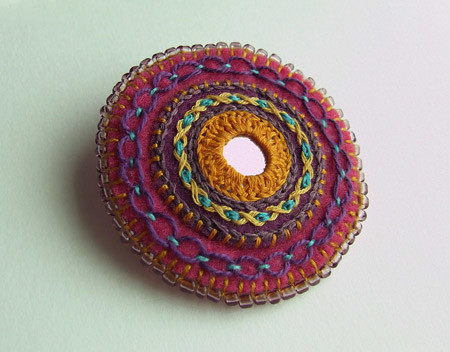
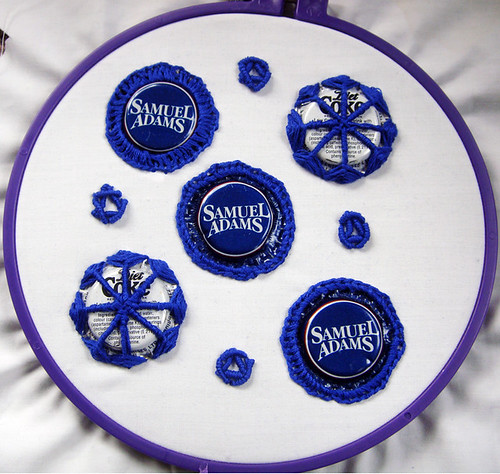
http://www.flickr.com/photos/pennynickels/4253772391/
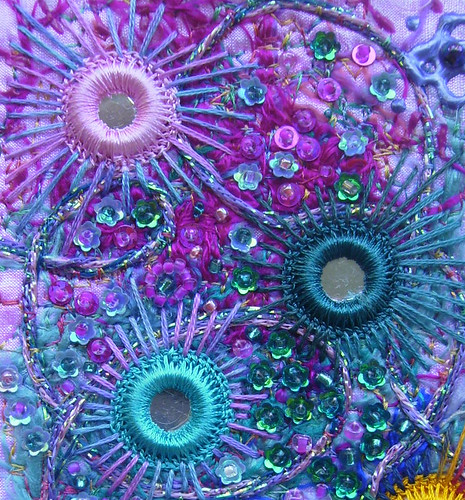
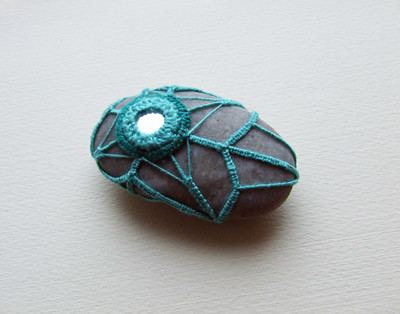
Have fun!
And if you do give it a go, I'd love to see some examples of what you end up with. Why not share links in the comments?






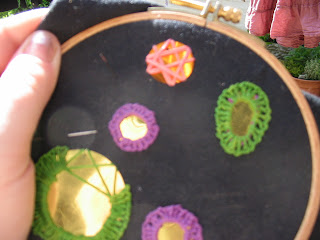



















No comments:
Post a Comment